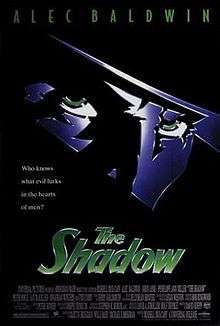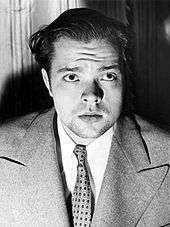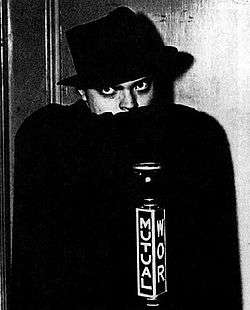The Shadow (1994 film)
| The Shadow | |
|---|---|
 | |
| Directed by | Russell Mulcahy |
| Produced by |
|
| Screenplay by | David Koepp |
| Based on |
The Shadow by Walter B. Gibson |
| Starring | |
| Music by | Jerry Goldsmith |
| Cinematography | Stephen H. Burum |
| Edited by |
|
Production company |
Bregman/Baer Productions, inc. |
| Distributed by | Universal Pictures |
Release date |
|
Running time | 108 minutes[1] |
| Country | United States |
| Language | English |
| Budget | $40 million |
| Box office | $48 million |
The Shadow is a 1994 American superhero film from Universal Pictures, produced by Martin Bregman, Willi Bear, and Michael Scott Bregman, directed by Russell Mulcahy, that stars Alec Baldwin. The film co-stars John Lone, Penelope Ann Miller, Ian McKellen, Jonathan Winters, Peter Boyle , and Tim Curry. It is based on the pulp fiction character of the same name created by Walter B. Gibson in 1931.[2]
It was released to theatres on July 1, 1994 and received generally mixed reviews. Critics found the villain, its screenplay, and the storyline lacking, but highly praised the direction, the acting, the soundtrack by Jerry Goldsmith, the special effects, its visual style, and the action sequences.
Plot
In Tibet, following the First World War, an American named Lamont Cranston (Alec Baldwin), succumbing to his dark instincts, sets himself up as a warlord and opium kingpin under the alias of Yin-Ko (said to mean "Dark Eagle" in Mandarin Chinese; "ying" means eagle, however it is unclear what "ko" means).[3] He is abducted by servants of the Tulku (Brady Tsurutani, voiced by Barry Dennen), a holy man who exhibits otherworldly powers and knows Cranston's identity. He offers Cranston a chance to redeem himself and become a force for good. Cranston refuses but is silenced by the Phurba (Frank Welker), a mystical sentient flying dagger. Ultimately, Cranston remains under the tutelage of the Tulku for seven years. In addition to undergoing rigorous physical training, he learns how to hypnotize others, read their minds, and bend their perceptions so that he cannot be seen—except for his shadow.
Returning to New York City, Cranston resumes his former life as a wealthy playboy. He secretly operates as The Shadow, a vigilante who terrorizes the city's underworld. He recruits some of the people he saves from criminals to act as his agents, providing him with information and specialist knowledge. Cranston's secret identity is endangered upon meeting Margo Lane (Penelope Ann Miller), a socialite who is also telepathic.
Shiwan Khan (John Lone), the Tulku's rogue protégé and murderer whose powers apparently surpass Cranston's, wakes up while in a sarcophagus that once kept his ancestor - the Mongol Empire founder Genghis Khan. He uses hypnosis to make a security guard (Ethan Phillips) shoot himself in the head after the guard refuses to join Khan's army. Khan plans to fulfill his ancestor's goal of world domination. He offers Cranston an alliance, but Cranston refuses. Cranston acquires a rare coin from Khan and learns that it is made of a metal called "bronzium" (an impure form of uranium) that theoretically can generate an atomic explosion. He learns that Margo's father Reinhardt (Ian McKellen), a scientist who works on building an atomic device for the Department of War, has disappeared, and realizes that Khan needs Reinhardt and his invention to build an atomic bomb.
Shiwan Khan hypnotizes Margo and commands her to kill the Shadow. She goes to Cranston's home, but Cranston breaks his hold on her. She realizes that since she was ordered to kill the Shadow and she instinctively went to Cranston's home, that he is the Shadow. Cranston prepares to rescue Margo's father but is thwarted by Khan's henchmen, especially when Reinhardt's assistant Farley Claymore (Tim Curry) allies with Khan. The Shadow discovers the location of Khan's hideout, the luxurious Hotel Monolith, a building in the middle of the city that Khan has rendered invisible. Knowing Reinhardt has completed the bomb under Khan's hypnotic control, The Shadow enters the hotel for a final showdown with Khan.
The Shadow fights his way through the building, and hypnotically influences Claymore to jump from a balcony to his death to prevent him from building another bomb. He finds Khan, but is subdued by the Phurba. The Shadow realizes that only a peaceful mind can truly control the Phurba and he seizes command of the dagger. The Shadow launches it into Khan's torso, creating a lapse in Khan's hypnotic control that frees Reinhardt and restores the hotel's visibility. The Shadow pursues Khan into the bowels of the building, while Margo and Reinhardt disarm the bomb. The Shadow defeats Khan by telekinetically hurling a shard of mirror into a frontal lobe of Khan's skull.
A confused Khan wakes up in a padded cell in a mental hospital, discovering that his powers are now gone. One of the doctors — also an agent of The Shadow — tells Khan that they were able to save his life by removing a part of his brain "that nobody uses", which in reality controlled his psychic abilities. Cranston and Margo begin a serious relationship and join forces to fight crime.
Cast
- Alec Baldwin as Lamont Cranston / The Shadow[4]
- John Lone as Shiwan Khan, a descendant of Genghis Khan.
- Penelope Ann Miller as Margo Lane
- Peter Boyle as Moses "Moe" Shrevnitz
- Ian McKellen as Dr. Reinhardt Lane
- Tim Curry as Farley Claymore[5]
- Jonathan Winters as Wainwright Barth
- Sab Shimono as Dr. Roy Tam
- Andre Gregory as Burbank
- James Hong as Li Peng
- Joseph Maher as Isaac Newboldt
- Max Wright as Berger
- Ethan Phillips as Nelson
- Frank Welker as the voice of Phurba
- Barry Dennen as the voice of Tulku (uncredited)
Production


Producer Martin Bregman bought the rights to The Shadow in 1982. Screenwriter David Koepp had listened to The Shadow radio show as a child when CBS radio re-ran it on Sunday nights. He was hired in 1990 to write a new draft and was able to find the right tone that the studio liked.[6] Bregman remembers, “Some of them were light, some of them were darker, and others were supposedly funnier – which they weren’t. It just didn’t work”.[7] Koepp's script relied predominantly on the pulp novels while taking the overall tone from the radio show with the actual plot originated by Koepp himself in consultation with Bregman.
In an attempt to differentiate the film from other superhero films of the time, Koepp focused on “the copy line, ‘Who knows what evil lurks in the hearts of men?’ and wondered how he knew what evil lurks in the hearts of men. And I decided that perhaps it was because he was uncomfortably familiar with the evil in his own heart”.[6] For Koepp, the film then became “a story of guilt and atonement”.[6] He picked Shiwan Khan as the film’s villain because “he was bold and he knew what he was doing – he wanted to conquer the world. That was very simple, maybe a little ambitious, but he knew exactly what he wanted.”[7] He had always been a fan of Alec Baldwin and wrote the script with him in mind: "He has the eyes and the voice; he had so much of what I pictured Cranston being".[6] Koepp also sat in on rehearsals and incorporated a lot of the actor’s humor into the script.[6]
The film was shot on the Universal backlot in Hollywood on five soundstages over 60 days with a five-day mini-unit tour of location shooting, and a week lost when an earthquake destroyed the Hall of Mirrors set. Mulcahy said, “There are a lot of FX in this film, but it’s not a FX film. It’s a character/story-driven film. The FX are part of the story.”[8]
Soundtrack
The film's original score was composed by Jerry Goldsmith, who used his at the time signature style of music for big orchestra (supported by a prominent percussion section) and musical effects with the help of instruments and especially synthesizers. Among the leitmotifs of his score are a romantically dark, yet lush heroic melodical main theme for the protagonist, which is accompanied by several secondary themes. For the antagonist, rather than a fully developed theme, Goldsmith used a musical effect in horns and synthesizers imitating a howling sound, a technique that would later echo in his scores for The Edge and The Ghost and the Darkness.
Camille Saint-Saëns's 1872 composition "Le Rouet d'Omphale" ("Omphale's Spinning Wheel"), which introduced the radio show, is not used in the film's score.
| The Shadow, Original Motion Picture Soundtrack | |
|---|---|
| Soundtrack album by Jerry Goldsmith | |
| Released | July 5, 1994 |
| Genre | Soundtrack |
| Label |
Arista Records 07822-18763-2 |
For the album and end credits, Jim Steinman composed the pop-song "Original Sin" performed by Taylor Dayne, originally appearing on the album Original Sin by the group Pandora's Box, while Diane Warren composed a period-style big-band piece "Some Kind of Mystery" to be performed in the movie by Sinoa.
| Professional ratings | |
|---|---|
| Review scores | |
| Source | Rating |
| Allmusic | |
Original album
The Arista Records label released a soundtrack album in 1994. The soundtrack featured selections from Goldsmith's score and the songs from the film, "Original Sin" in two different versions.[10]
Track listing
- 'The Shadow Knows', 1994 - Alec Baldwin (0:08)
- Original Sin (Theme from The Shadow) - Taylor Dayne (6:27)
- The Poppy Fields (Main Title) (3:16)
- Some Kind of Mystery (Warren) - Sinoa (3:48)
- The Sanctum (3:33)
- Who Are You? (4:02)
- Chest Pains (3:26)
- The Knife (3:05)
- The Hotel (5:53)
- The Tank (4:08)
- Frontal Lobotomy (2:28)
- Original Sin (Theme from The Shadow) Film Mix - Taylor Dayne (5:02)
- 'Who Knows What Evil Lurks in the Hearts of Men?' - Orson Welles (from The Shadow Radio Show, 1937) (0:29)
Complete score release
In 2012, Intrada released a 2-CD package that features the world premiere of the entire soundtrack composed by Jerry Goldsmith and among other bonus tracks also the complete original album cut on the second disc.
| The Shadow, Complete Motion Picture Soundtrack | |
|---|---|
| Soundtrack album by Jerry Goldsmith | |
| Released | 2012 |
| Genre | Soundtrack |
| Label | Intrada |
Track listing
CD one
- The Poppy Fields (3:41)
- The Clouded Mind (6:43)
- I'll Be There (3:55)
- No Shadow (0:33)
- Secrets (3:08)
- Don't Open It! (4:15)
- Do You Believe? (2:24)
- The Sanctum (3:34)
- Who Are You? (4:46)
- The Code (0:59)
- The Call (2:36)
- No Thought (1:19)
- Chest Pains (3:27)
- A Mission (2:35)
- Nice Tie (2:49)
- The Knife (3:06)
- What I Know (4:48)
- The Jumper (1:21)
- The Tank (4:06)
Total Time = 60:09
CD two
- The Dream (1:59)
- Get Dr. Lane (1:05)
- The Hotel (5:55)
- Fight Like a Man (4:13)
- The Mirrors (4:58)
- The Mirrors (Alternate Version) (4:04)
- Frontal Lobotomy (2:30)
- Wild Drums (0:19)
- [Source music] Dinner Source (Dennis Dreith) (1:06)
- [Source music] Bart's Bounce (Dennis Dreith) (2:06)
- [Original album] 'The Shadow Knows', 1994 - Alec Baldwin (0:08)
- [Original album] Original Sin (Theme from The Shadow) - Taylor Dane (6:27)
- [Original album] The Poppy Fields (Main Title) (3:16)
- [Original album] Some Kind of Mystery (Warren) - Sinoa (3:48)
- [Original album] The Sanctum (3:33)
- [Original album] Who Are You? (4:02)
- [Original album] Chest Pains (3:26)
- [Original album] The Knife (3:05)
- [Original album] The Hotel (5:53)
- [Original album] The Tank (4:08)
- [Original album] Frontal Lobotomy (2:28)
- [Original album] Original Sin (Theme from The Shadow) Film Mix - Taylor Dane (5:02)
- [Original album] 'Who Knows What Evil Lurks in the Hearts of Men?' - Orson Welles (from The Shadow Radio Show, 1937) (0:29)
Total Time = 74:56
Reception
Box office
The film was meant to be a summer blockbuster and the starting point for a new film franchise with toy, game, and clothing lines. However, the film suffered from competition for its target audience with, among others, The Lion King (during its early run) and The Mask (later on), and it was ultimately a financial disappointment.[11][12][13] The film started off strongly, debuting at No. 2, but failed to sustain any momentum,[12][14] and grossed $32 million domestically, with a worldwide total of $48 million[15] against a budget of $40 million. The planned franchise never materialized.
Critical
The film received mostly mixed-to-negative reviews. It holds a 35% rating on the film review aggregator website Rotten Tomatoes from a sample of 46 critics, with the consensus: "Visually impressive, but ultimately forgettable". The more detailed summary described the film as having "impressive" visuals and a story that does not "strike a memorable chord".[16] Entertainment Weekly placed the film on its "21 Worst Comic-Book Movies Ever" list.[17] However, on the Siskel and Ebert syndicated review TV series, noted critic Roger Ebert gave the film a positive review.
Despite its failure, the film has retained a cult following in subsequent years, a result of its video success on VHS, DVD, and Blu-ray, much like two other 1990s pulp/comic adaptations, The Rocketeer and The Phantom.
In other media
Novelization
James Luceno wrote the novelization[18] which went deeper into the events of the film and included many nods to the radio show and the original pulp magazines, most significantly alluding to the fact that The Shadow's true identity was Kent Allard and that 'Lamont Cranston' was just another identity he assumed.[19]
Video game
A video game version of The Shadow for the Super NES was developed to tie in with the 1994 film,[20] but after the low box office gross, was never released despite being completed. [21]
Pinball game
Midway (under the Bally label) released a Shadow-themed pinball machine in 1994. Brian Eddy of Attack From Mars and Medieval Madness fame designed the game. It was his first pinball game design, and it was moderately successful. Dan Forden composed original music for the game.
References
- ↑ "The Shadow (12)". British Board of Film Classification. July 15, 1994. Retrieved September 27, 2016.
- ↑ "Baldwin's 'Shadow' Achieves Pale Silhouette Of Its Potential". Orlando Sentinel. Retrieved January 21, 2011.
- ↑ "The Shadow Unmasks" (1937). In print, The Shadow's real name is Kent Allard, and he was a famed aviator who fought for the French during World War I. He became known by the alias the Black Eagle, according to "The Shadow's Shadow" (1933), although later stories revised this alias as the Dark Eagle, beginning with "The Shadow Unmasks" (1937)..
- ↑ "What Humor Lurks In `The Shadow'? Alec Baldwin Knows". Morning Call. Retrieved January 12, 2011.
- ↑ "Tim Curry Has Another Outlandish Role In 'Shadow'". Orlando Sentinel. Retrieved January 21, 2011.
- 1 2 3 4 5 Schwager, Jeff (August 13, 1994). "Out of the Shadows". Moviemaker. Archived from the original on November 14, 2006. Retrieved April 16, 2007.
- 1 2 Peterson, Don E (August 1994). "The Shadow Takes Shape". Sci-Fi Entertainment.
- ↑ Murray, Will (August 1994). "Master of Death". Starlog. Retrieved April 16, 2007.
- ↑ https://www.allmusic.com/album/mw0000115539
- ↑ The Shadow soundtrack review at Filmtracks.com
- ↑ Wilmington, Michael (July 1, 1994). "Sumptuous Sets Can't Hide Flat Storyline Of `The Shadow'". Chicago Tribune. Retrieved January 12, 2011.
- 1 2 Natale, Richard (July 6, 1994). "Fresh Ideas Pay Off at Box Office : Movies: Strong openings boost concept films such as 'Speed,' 'The Shadow' and other original ideas, while star vehicles stall". The Los Angeles Times. Retrieved January 12, 2011.
- ↑ Turan, Kenneth (July 1, 1994). "Movie Reviews `The Shadow': The Look Says It All Exciting visuals help bring film to life, but able actors can't make the writing right". The Los Angeles Times. Retrieved January 12, 2011.
- ↑ "Fourth of July Weekend Box Office". The Los Angeles Times. July 7, 1994. Retrieved January 12, 2011.
- ↑ "The Shadow at Box Office Mojo".
- ↑ "The Shadow (1994)." Rotten Tomatoes.
- ↑ "20 Worst Comic-Book Movies Ever The Shadow, Alec Baldwin." Entertainment Weekly.
- ↑ Luceno, James (1994). The Shadow. New York: Ivy Books. ISBN 9780804112963.
- ↑ Sims, Chris (August 12, 2016). "Ask Chris #302: All The Fun Of A VHS Tape In Comic Book Form". ComicsAlliance. Retrieved October 18, 2016.
- ↑ "The Shadow - Super NES". IGN. Retrieved October 18, 2016.
- ↑ Laraque, J.A. (May 19, 2011). "Unreleased: The Shadow". ObsoleteGamer.com. Retrieved October 18, 2016.
External links
| Wikiquote has quotations related to: The Shadow (1994 film) |